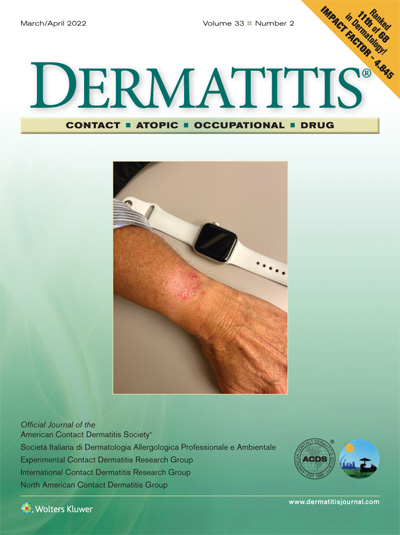Correlation of Disease Severity, Proinflammatory Cytokines, and Reduced Brain Gray Matter Volumes in Patients with Atopic Dermatitis.
IF 3.2
3区 医学
Q1 DERMATOLOGY
引用次数: 0
Abstract
Background: Atopic dermatitis (AD) is a chronic inflammatory skin disease. However, few studies have investigated brain changes associated with chronic inflammation. We hypothesized that chronic inflammation might be related to brain structural alterations in patients with AD. Objectives: To investigate the association between disease severity (Eczema Area and Severity Index [EASI]), proinflammatory cytokines, and differences in brain gray matter (GM) volume in patients with AD. Methods: Nineteen patients with AD and 19 age- and sex-matched healthy subjects were enrolled. All participants underwent clinical assessment and brain magnetic resonance imaging. Voxel-based morphometry was performed to analyze GM volume differences. Results: Patients with AD exhibited significantly decreased GM volume in many brain regions, such as bilateral precentral gyrus, right frontal pole, and right middle temporal gyrus (P < 0.001), compared with healthy subjects. Notably, in patients with AD, the GM volume in right middle temporal gyrus was negatively associated with both EASI score and proinflammatory cytokines (sIL-2R [soluble interleukin 2 receptor] and TNF-α receptor-1), whereas the GM volume in left precentral gyrus was negatively associated with both EASI score and proinflammatory cytokines (sIL-2R and CRP). Conclusion: Patients with AD demonstrated significant brain GM volume reduction in many brain regions, which is related to disease severity and proinflammatory cytokines.特应性皮炎患者疾病严重程度、促炎细胞因子与脑灰质体积减少的相关性
背景:特应性皮炎(AD)是一种慢性炎症性皮肤病:特应性皮炎(AD)是一种慢性炎症性皮肤病。然而,很少有研究调查与慢性炎症相关的大脑变化。我们假设慢性炎症可能与 AD 患者的大脑结构改变有关。研究目的研究 AD 患者的疾病严重程度(湿疹面积和严重程度指数 [EASI])、促炎细胞因子与脑灰质(GM)体积差异之间的关联。研究方法招募 19 名 AD 患者和 19 名年龄与性别匹配的健康受试者。所有参与者均接受了临床评估和脑磁共振成像检查。采用基于体素的形态计量学方法分析大脑灰质体积的差异。结果显示与健康受试者相比,AD 患者的许多脑区,如双侧中央前回、右额极和右颞中回的 GM 体积明显减少(P < 0.001)。值得注意的是,在 AD 患者中,右颞中回的 GM 体积与 EASI 评分和促炎细胞因子(sIL-2R [可溶性白细胞介素 2 受体] 和 TNF-α 受体-1)均呈负相关,而左侧中央前回的 GM 体积与 EASI 评分和促炎细胞因子(sIL-2R 和 CRP)均呈负相关。结论AD患者多个脑区的脑基因组体积明显缩小,这与疾病严重程度和促炎细胞因子有关。
本文章由计算机程序翻译,如有差异,请以英文原文为准。
求助全文
约1分钟内获得全文
求助全文
来源期刊

Dermatitis
医学-皮肤病学
CiteScore
5.30
自引率
11.50%
发文量
251
审稿时长
>12 weeks
期刊介绍:
Dermatitis is owned by the American Contact Dermatitis Society and is the home journal of 4 other organizations, namely Societa Italiana di Dermatologica Allergologica Professionale e Ambientale, Experimental Contact Dermatitis Research Group, International Contact Dermatitis Research Group, and North American Contact Dermatitis Group.
Dermatitis focuses on contact, atopic, occupational, and drug dermatitis, and welcomes manuscript submissions in these fields, with emphasis on reviews, studies, reports, and letters. Annual sections include Contact Allergen of the Year and Contact Allergen Alternatives, for which papers are chosen or invited by the respective section editor. Other sections unique to the journal are Pearls & Zebras, Product Allergen Watch, and news, features, or meeting abstracts from participating organizations.
 求助内容:
求助内容: 应助结果提醒方式:
应助结果提醒方式:


